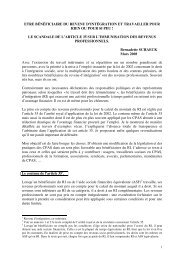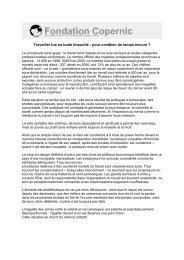Awra Amba RJ 300612 EN - Contacter un comité local d'Attac
Awra Amba RJ 300612 EN - Contacter un comité local d'Attac
Awra Amba RJ 300612 EN - Contacter un comité local d'Attac
You also want an ePaper? Increase the reach of your titles
YUMPU automatically turns print PDFs into web optimized ePapers that Google loves.
2. Backgro<strong>un</strong>d history and geographical situation<br />
2200 m) and is occupied by crops at 88 %, by grass (22 ha) and forest at 3 % each, and by<br />
homesteads at 6 %. The major crops that grow in the area are tef, millet, nuge, maize, beans and peas<br />
(ORDA, nd, cited by At05/26-27). Precipitation is about 1440 mm water a year according to ORDA,<br />
but between 1200 and 1250 mm acc. to ILRI and MoA (2005). The people suffer malaria, worsened<br />
by poor feeding conditions (At05/99).<br />
One of the kebeles of the Fogera woreda is Woji-Arba-<strong>Amba</strong> one (Me09/4) (or Arba-<strong>Amba</strong> acc. to<br />
Yi07; or Wojeina-Arvamba acc. to At05/28; or Wej Arba <strong>Amba</strong> acc. to CSA, 2007/325: Question 14<br />
in Annex), which administers <strong>Awra</strong> <strong>Amba</strong> as well as the villages (gotoch) of Maksegn, Dej Mesk,<br />
Jib Gudguad: see Picture 3. Maksegn is the village where are located the primary school used by<br />
<strong>Awra</strong> <strong>Amba</strong> children till 2009 and the market where the <strong>Awra</strong> <strong>Amba</strong> inhabitants buy and sell<br />
(Yi07/62). This kebele had 8 908 inhabitants in 2007 (CSA, 2007/325), and more than 10 000 in<br />
2008 according to Me09/76, which seems surprising in comparison with CSA figure.<br />
The village of <strong>Awra</strong> <strong>Amba</strong> is a part of this kebele. It is located 13.7 km far from Woreta, 68 km from<br />
Bahar Dar, and 630 km from Addis Ababa (Me09/75): see Figure 7 and Figure 8. To go here, you<br />
have to leave the sealed Bahar Dar - Gondar road and aro<strong>un</strong>d one kilometre after Woreta drive eight<br />
to ten kilometres over a road sealed in 2010 in the direction of Debre Tabor and then a 2-kilometre<br />
track to the South, paved by <strong>Awra</strong>-<strong>Amba</strong> comm<strong>un</strong>ity (At05/28). The location of the village is called<br />
Turigne or Turegn (At05/28; Yi07/46), Thuregne or Taika acc. to Me09/4 & 29 (Question 15 in<br />
Annex): see Picture 4.<br />
Picture 4:<br />
Territory of The <strong>Awra</strong> <strong>Amba</strong> comm<strong>un</strong>ity, with at middle-distance, on the right of the<br />
boscage and in the front of the village, the weaving workshop.<br />
The village of <strong>Awra</strong> <strong>Amba</strong> borders the villages of Quarke to the south, Tizaba (or Tizab) and<br />
Maksegn to the east, Arba Chane to the west, and Jib Gudguad to the north west (At05/28; Yi07/44).<br />
According to ORDA (nd, cited by At05/28 and repeated by Ya08/50), the total land area of the<br />
comm<strong>un</strong>ity is 43 ha, including 28.2 ha cultivated land, 11 ha grass, 1.3 ha protected as bush, and<br />
2.5 ha settlement. The village of <strong>Awra</strong> <strong>Amba</strong> would have thus half of the grass of the sub-watershed<br />
of <strong>Awra</strong> <strong>Amba</strong>, which is 16 times wider, which is surprising (Question 11 in Annex). However,<br />
according to Ya08/97 and Jo10b/2, the surface of the comm<strong>un</strong>ity would be only 17.5 ha, including<br />
10.2 ha crops where fallowing is not practiced and fertility medium. The site has a good vegetation<br />
cover, especially Acacia and Eucalyptus, which are very common in the <strong>Awra</strong> <strong>Amba</strong> area. But<br />
deforestation remains a challenge (Ya08/50).<br />
This small surface area gives a population density aro<strong>un</strong>d four times higher than in the surro<strong>un</strong>dings:<br />
930 inh./km 2 in 2007, while it is 247 inh./km 2 in Fogera woreda according to the census of the same<br />
year (CSA, 2007) – these densities being in 2005 respectively 847 and 181 inh./km 2 according to<br />
At05/39. The density of the comm<strong>un</strong>ity would be even 2286 inh./km 2 if we accept a surface area of<br />
17.5 ha.<br />
29 / 85

















